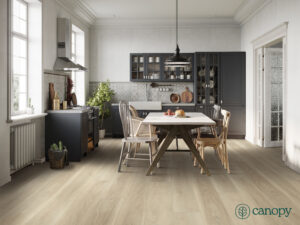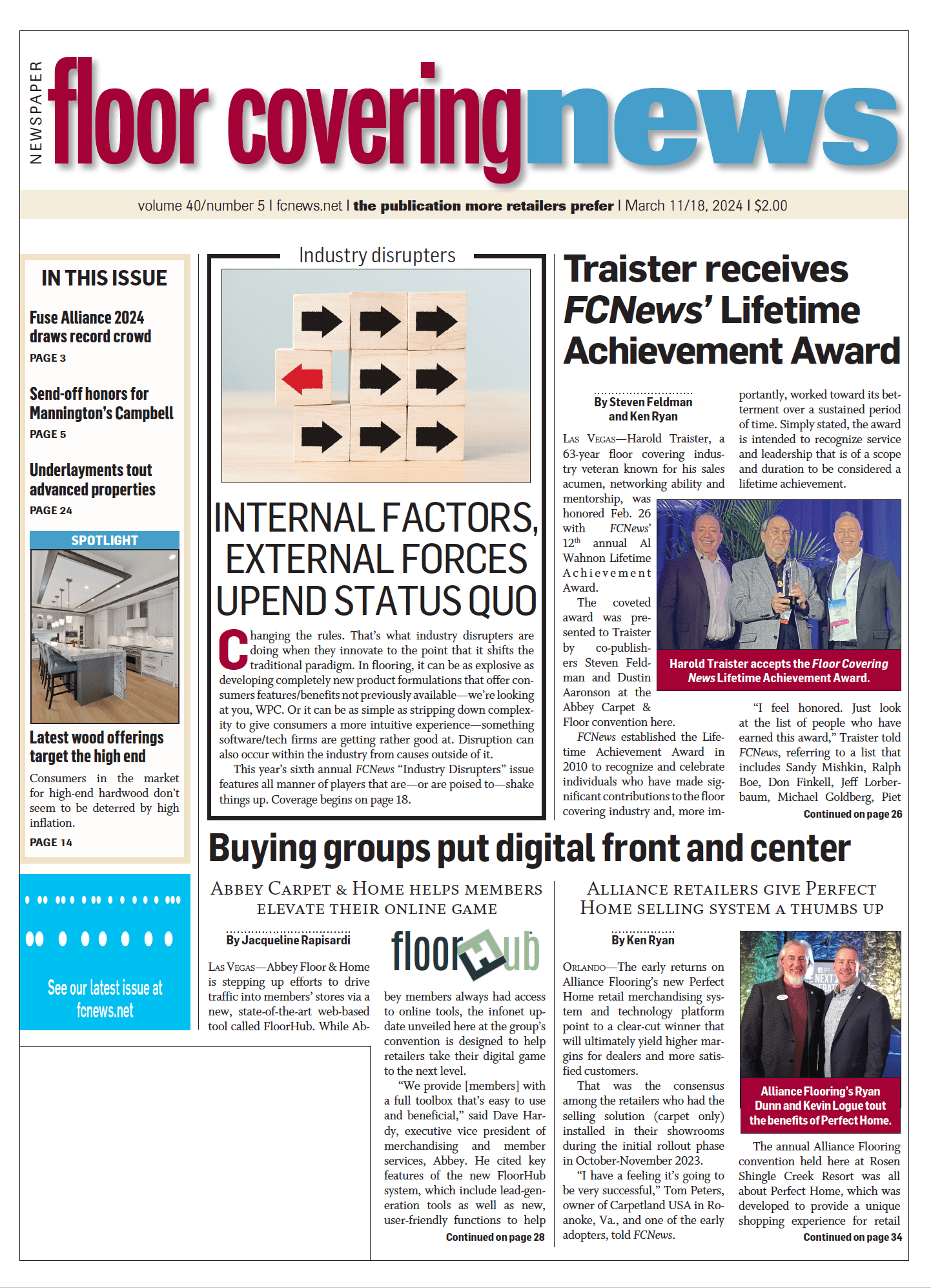 Dalton—It has been 12 years since Piet Dossche turned the flooring industry upside down when he launched WPC in the United States and soon after its SPC iteration, all under the “waterproof” umbrella. All totaled, this segment reached nearly $6 billion in 2022 and helped put many retailers’ kids through college and then some.
Dalton—It has been 12 years since Piet Dossche turned the flooring industry upside down when he launched WPC in the United States and soon after its SPC iteration, all under the “waterproof” umbrella. All totaled, this segment reached nearly $6 billion in 2022 and helped put many retailers’ kids through college and then some.
Fast forward to 2024 and Dossche’s sons, Julian and William, are looking to make a splash of their own with their Hall-of-Fame father as an advisor. International Flooring Co. is the company and Canopy is the brand retailers are going to want to keep on their radar. The Dossches took the wraps off Canopy at Surfaces in a private space on the showroom floor, and suffice to say the response was overwhelming.
“Our philosophy was twofold,” said Julian Dossche, president. “One, we’re still a startup, so we’re going to act as such managing our finances accordingly. But also, we are building a brand that has limited distribution. The private space allowed us to be more intentional with who we met with as we take our first steps.”
The goal at Surfaces, Dossche said, was to explain what this brand will do for retailers. But equally important, how the brand will be different than everything they saw on the show floor. “It gave us the opportunity to hold more intimate, one-on-one discussions.”
Word traveled fast. Appointments were designed to be by invitation only, but a funny thing happened on the way to the forum. “We noticed toward the end of the show people were seeking us out because people started to talk. The first day was purely invitation only, then the second day we started to hear a few more whispers amongst the halls. By the third day it was kind of, ‘We need to come see you.’ So we actually opened up some accounts that we had no appointments with coming into the show.”
Greg Wrenn, vice president of product and brand, told FCNews that it’s a unique partnership with retailers that resonated. “It is really focused on uplifting each other and capturing the consumer,” he said. “We really wanted to target retailers who we know will pay attention to the brand and make it a priority.”
Dossche put it in perspective. “For Canopy to be successful, we want to be impactful in the industry but in a meaningful and uplifting way—but also be impactful with the retailer. So not just dead displays taking up space, but a display that’s actively helping that retailer achieve its goals. And finally, be an impactful member of that retailer’s community. In the end, we build product to make somebody’s space beautiful, attainable and something they can be proud of. The retailer is a key element to that, we are a key element to that.”
 Not just product—an ecosystem
Not just product—an ecosystem
Dossche noted that Canopy is more than a collection of products; it’s an ecosystem. And that is the differentiator because Canopy is first looking to capture the common consumer.
How? “We start where the consumer lives,” Wrenn explained. “And today they live online. They start their search on Google. So how do we as a company empower the brand but also the retailer to capture and convert that consumer? We’re basically creating a digital ecosystem, a digital touchpoint, that starts the consumer’s journey and guides them from ‘I don’t understand anything about hard surface’ to ‘Wow, WPC actually might be the best product for my kitchen remodel. Oh, and by the way, there’s a really strong partner in Chattanooga, five miles down the road from me.’ So instead of a display just taking up valuable real estate, it is now a silent salesman. It’s actively working behind the scenes. So our goal is to meet that consumer online, where they are, educate, inspire and bring them to our retailers.”
There is going to be some degree of exclusivity to Canopy because, as Dossche pointed out, that has been retailers’ No. 1 ask. So it will not be everywhere. It certainly won’t be in the big box. But there does have to be a balance to generate enough economies of scale to satisfy and move the needle for all parties within Canopy’s supply chain. “If we don’t create those economies of scale, we’re not creating value, and the brand will fall flat on its face.”
The other differentiator is that all Canopy products will be created intentionally to provide solutions for the consumer. For example, SPC will fall under the “performance” moniker, while WPC will be more focused on comfort. “We’re going to speak in very consumer-centric and consumer-friendly language,” Wrenn said. “A little more casual, a little more approachable. So we’ll have performance and comfort initially, and if we create the ecosystem appropriately, we can build on that to solve any problem for the consumer, whether it be laminate or wood or something else.”
Dossche knows that the average consumer doesn’t understand the differences between wood, laminate, WPC, SPC, vinyl, etc. “They’re looking for one thing: a product that solves a problem for their lifestyle. If a consumer has young children or pets, she is probably going to be more focused on products that perform.”
Canopy launches in May with WPC and SPC; however, laminate and wood could soon be part of the offering. “We have some products that might not be that complete ‘wow’ the same way as when my father debuted WPC but will solve problems for the consumer,” Dossche said. “And we’re going to start looking to launch those, once we feel comfortable, once we have our foundations set, probably toward the end of this year.”
Profit margin opportunities
Why else should retailers be interested in Canopy? Simply put, because they can make money. Dossche said they can easily make a 40%-50% margin and above. “The No. 1 challenge we have in this industry is we love to race to the bottom,” he said. “There is a lot of pressure against us to keep coming down. My dad always said, ‘Everybody has to make profit.’ And if we race to the bottom, instead of building a product that lasts 20-plus years, you’re now just building a product that lasts five years and everybody’s moved on.”
Retail price points for WPC will range from $3.99 to $7.99. Products are differentiated by thickness (8mm, 12mm, 15mm) and design. Dossche said those favoring rustic looks may gravitate toward the 8mm. “If you’re going for a little less variation, you’ll probably end up with that 12mm. And if you’re looking for just very modern, clean looks, you’re going to end up with that 15mm.” The latter features the higher-end 9 x 84 long/wide boards. There is an attached 3mm cork backing on the 12mm and 15mm WPCs and a 1.5mm cork backing on the 8mm as well as the SPC.
The SPC will retail around $3.99. “We are pushing the thickness up on the SPC,” Dossche said. “We’re not going to play in that thin stuff.”
In a perfect world, Dossche is hoping to have between 500 and 750 Canopy displays on the street by the end of the year with that number growing to 1,500 by the end of 2025. “Again, the whole concept for this brand is to be limited in its distribution,” he said. “Not to the point where we’re not everywhere. We have to be able to support the markets in which we actively work.”
Sourcing strategy
Another advantage inherent with Canopy is nothing is made in China, meaning the products are not subjected to the 25% tariff. WPC is manufactured in Vietnam while some of the SPC is made domestically.
“One thing the pandemic did was it quickly showed the weaknesses in supply chains,” Dossche said. “So we are constantly looking to not only diversify our supply chain, but also strengthen it. If we look at some of the geopolitical turmoil, tariffs are a part of that. Right now China doesn’t make the most sense to attach our horse. Vietnam has more advantage on the financial side but still has risk because it is within that area where turmoil could happen. Everybody talks about Taiwan. What is going to happen there? And the Russia-Ukraine conflict has created a lot of turmoil, not only just in the raw material space, but energy prices in Europe spiked. So then it became a challenge for European manufacturers to become more competitive. So if you’re a company like Canopy trying to build a brand that can support and help a retailer build his business, you have got to look at pretty much everything and say, ‘Where are my weak points?’”
To that end, Dossche said he sees “near-shoring” as the way to go. “Onshoring, with our U.S.-made products, is a great strategy. Don’t put all your eggs in one basket. And make sure you diversify, both in terms of where you’re located, but also how you get products to people.”

